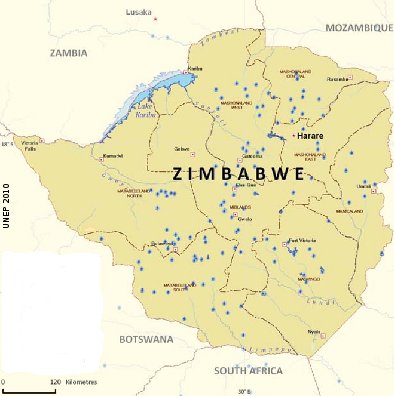Mean annual rainfall is low and many rivers in the drier parts of the country are not perennial.
Economy in Zimbabwe
Agriculture and the smallholder farming sector dominate Zimbabwe’s economy contributing about 17% to the country’s GDP. Agriculture provides employment and livelihoods for about 70% of the population, including 30% of formal employment, and accounts for about 40 to 50% of the country’s total export revenues.
About three-quarters of Zimbabwe’s population live in the rural smallholder farming sector and depend on agriculture for their livelihoods. Agricultural production processes, particularly plant growth, are dependent on climatic conditions. This makes agricultural activities extremely vulnerable to climatic changes.
Climate change in Zimbabwe
Meanwhile, climate change is expected to pose a particular challenge for agriculture and for instance food production. More frequent and prolonged droughts and increases in temperature can seriously reduce crop yield, especially maize, which is a staple crop in Zimbabwe. Reduced water runoff is also expected to affect the quality and quantity of water available for domestic and industrial use, and limit hydropower production, most significantly at Kariba hydropower station and others alike.
Zimbabwe is vulnerable to climate change principally through shifting rainfall patterns and extreme weather events. The country is experiencing more hot days and fewer cold days, and the amount of precipitation it receives is deviating from the mean more frequently.
The impacts of increased temperature, reduced rainfall and run-off are felt in many sectors of the economy with varying severity. Other vulnerable sectors include biodiversity, tourism and infrastructure. Socio-economic impacts arising from climate change impacts on water and wetlands are likely to include shortages of water, food insecurity, poor health and damage to infrastructure.
WACDEP implementation
Zimbabwe’s ability to manage its water resources is critical to its economic growth. The country has made extensive investments in large, small, and medium dams, though current utilization is only about 22% of mean annual run-off. WACDEP focus should be in the areas of increasing the efforts of the government in the identified areas of investments.
WACDEP can play a crucial role in informing farmers of the need for crop diversification, soil water management and water harvesting as well as the use of appropriate fertilizers to assist small- scale and subsistence farmers through the drought recovery program. WACDEP can support the government to set up a high- level interagency task force to develop a coherent national drought policy. WACDEP should focus on strengthening the government’s efforts for improvement in the water balance and reduce water stress.
All these are important as; farmers therefore need seed varieties that can stay in the soil for some time before the rains come, as well as early maturing varieties. Diversifying crops, planting different crops or crop varieties, replacing farm activities with nonfarm activities, changing planting and harvesting dates, increasing the use of irrigation, and increasing the use of water and soil conservation techniques.
